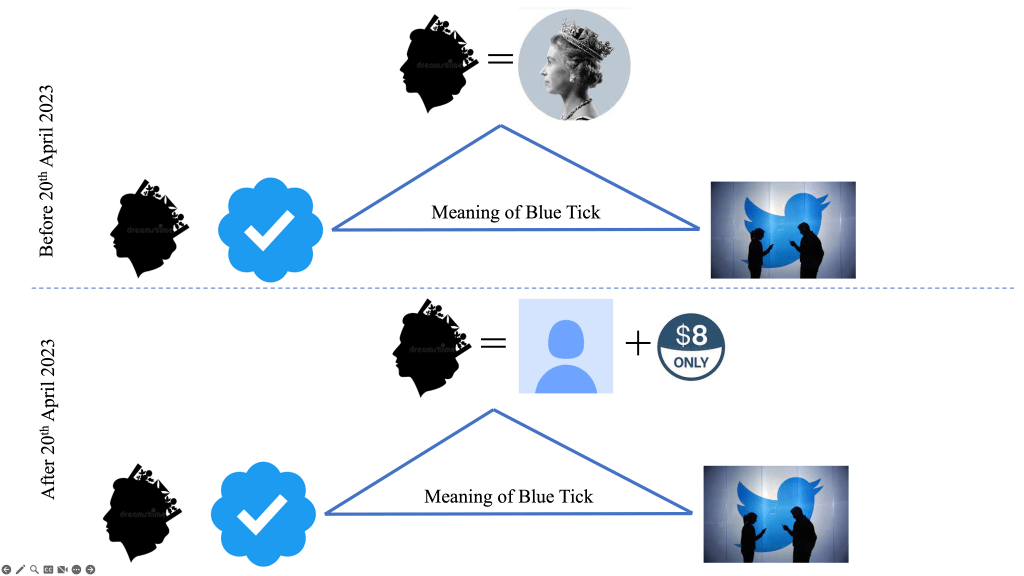Last Thursday (20th April 2023), Twitter began removing the blue ticks from formerly verified users who had failed to subscribe to the new Twitter Blue service.
The blue tick was once a symbol of “authenticity”, confirming that the holder of that account was indeed the person or institution referred to in the name or description of the account. Moreover, as the symbol was awarded to notable users (e.g., celebrities), it conferred a certain status to the respective account holders. Now, however, the same symbol has a different meaning. Now, the blue tick has come to denote someone that has subscribed to the Twitter Blue service, which, at the time of writing, includes features such as being able to edit tweets, fewer ads, longer messages, and content boosts. Here is a depiction of the change using the semiotics’ triangle: for the referent group of Twitter users, the symbol appended to an account (say, the late Queen Elizabeth II) has now come to denote a completely different object or concept.
Is this just a question of semantics? Or, does this change matter and, if so, for whom?
To unpack these questions we need to consider a number of issues, including: the meaning of the blue tick symbol, the value of user verification, and the consequences for different types of users.
Let’s try to do that.
Issue: Same symbol, new meaning
The problem here is one of communication.
When people use the same symbol to mean different things, misunderstandings occur. The consequence of that misunderstanding could be just wasted time, but it could also be wasted money, missed opportunities, conflict…
Think of the hand sign that brings your thumb and your index finger together which means OK in some cultures vs. money in others, but could also be deemed an homophobic or racist insult in other contexts.
Whether on purpose (because Twitter wanted to hold on to the halo effect of the old meaning), or through negligence, by keeping the same symbol, Twitter is creating a situation where some users may misunderstand what the symbol stands for. Specifically, they may interpret the symbol as still representing the authenticity of the account and, indirectly, the notable status of the account holder. The misunderstanding is further compounded by the fact that, at the time of writing this, Twitter continues to use the blue tick for some accounts that have not subscribed to the service.
An example of this confusion – and its consequences – occurred when an account with the username @EliLillyandCo, and the “new” blue tick, tweeted that: “We are excited to announced insulin is free now.”
Users thought that the account belonged to the pharmaceutical company Eli Lilly (which uses the Twitter handle @LillyPad), and quickly amplified the message with numerous likes and retweets. The misunderstanding reputedly drove down the value of Eli Lilly’s shares plus, no doubt, generated much confusion and time wasted among patients, medical professionals, charities and so on.
The problem of misunderstanding could have been easily avoided: If Twitter wanted to minimise the risk of misunderstandings, it should have used a new, different symbol for the new service.
Issue 2: Lack of authenticity signifier
The problem here is one of value.
The “old” blue tick was a short-cut to show / assess the authenticity of the account holder. In other words, that a) users could trust the content produced by a given account; and that b) account holders could trust that no other users would be able to impersonate them.
Trust has been shown to be essential in driving use of social media channels, both for content users and for content producers, over and above functional features. As a content user, if I can’t trust that what I am reading is true, I am unlikely to rely on the platform for information. I am also unlikely to follow new users, and to like or retweet the content.
The ability to demonstrate the authenticity of the identity of the account holder is somehow limited, even when there is no intent to deceive other users. Just think about the North American retired teacher John Lewis, who gets bombarded with messages intended for the UK retailer John Lewis, even though the former specifically says in his profile that he is not the latter.
The ability to assess the authenticity of the account holder’s authenticity is even more difficult. At a minimum, we will need to check when the account was opened, the number of followers and the activity on the account. This is likely to be difficult if one is using Twitter on their phone, and for users that are new to the platform, to name a few.
That is, the absence of a short-cut (such as the old verification icon), reduces the value of the platform for Twitter users (because of the reduced ability to trust the content on the platform), and increases the cost of verifying authenticity for both content producers (e.g., a news outlet) and content users. I am guessing that this also reduces the value of Twitter as an advertising medium, a customer service channel, a source of customer insight (e.g., Sentiment analysis) and so on.
The problem of value is harder to solve: in the absence of a quick and unambiguous way of signalling authenticity, Twitter needs to find other ways of increasing trust in the platform. This would require enhanced identity verification mechanisms, plus quick and effective “weeding out” of impersonators, which will be a challenge in this era of cost-cutting.
The table below summarises these consequences for both types of users:

Twitter does find itself in a difficult situation. Whether the additional revenue from the blue and golden ticks will make up for the all the upheaval remains to be seen. But what is certain is that, in the meantime, users find themselves trying to navigate a very murky environment.



